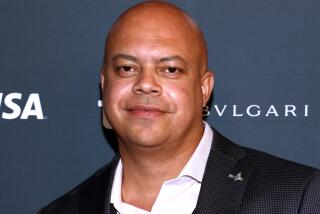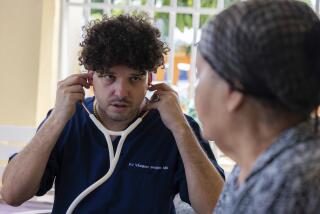Endless Street Violence, Deaths Take a Personal Toll on Gang Counselor : Battle fatigue: Mediator had devoted his life to trying to keep peace. Now he fights his own battle to put his world back together.
Maybe it was one too many bullets whizzing past his head that finally got under his skin. Or maybe it was the list of dead kids that Manuel Velazquez carried everywhere, reminding him that his failures are marked with tombstones.
Velazquez, a soft-spoken, round-faced man who has worked on the front lines trying to prevent gang violence in the San Fernando Valley for 10 years, still is not certain what caused his world to start falling apart.
But the 31-year-old workaholic gang counselor remembers the exact moment when he became another victim of the ongoing street warfare in Southern California.
That his wound turned out to be self-inflicted made it no less painful.
“It hit me, ‘I’m going to have a heart attack,’ ” he recalled thinking as he collapsed two years ago outside a Carlos Santana concert in Santa Barbara. Sweating profusely and suffering from vertigo, a racing heartbeat and wildly fluctuating blood pressure, Velazquez was convinced his life was ending. But all he could think about was how he was spoiling the concert for his wife and friends.
It wasn’t a heart attack, but it was months later before Velazquez found out it was a mental, not physical, malady. Velazquez said he was diagnosed as suffering from anxiety attacks, sometimes as many as a dozen each day, which battered him so severely that he became reclusive and began to avoid the street and the work that once consumed him.
At his lowest point, he contemplated suicide. He had the method all worked out. All he had to do was get in the middle of a gun battle some night.
“I was hoping to die on the job,” he said in an interview at his apartment in the foothills of Sylmar. “I didn’t care anymore.”
Velazquez works for the Community Youth Gang Services Project, an elite, if not highly paid, group whose members have dedicated their lives to being mediators on gang turf. Their job is not to solve crimes, but to open a channel of communication with gang members.
Cruising the mean streets at night, they try to prevent violence from occurring. After it does, they often are the first to know why. Without guns or badges, they have only the authority of their own street savvy, yet they have won respect from both the police and the gangs. But the fact that they have come to know those who both kill and are killed leaves them vulnerable.
“In war, they have a term for it. They call it battle fatigue,” said Steve Valdivia, Velazquez’s boss and the executive director of the gang services project, which employs 86 counselors and other workers on an annual budget of $2.6 million.
“Manuel takes the death of young people very personally,” Valdivia said. “There are a lot of good people I fear for in relation to the toll this job takes. They have to maintain a level of objectivity.”
But that has always been difficult for Manuel Velazquez, the son of a Mexican immigrant who grew up in Pacoima and San Fernando. Even in his youth there was rivalry between neighborhoods in the two cities, so he often found himself in the middle.
“I talked a lot of guys out of beating each other’s brains in,” he said.
After high school, Velazquez enrolled at Cal State Northridge and helped set up a landmark gang peace conference in 1980 that was held to deal with surging gang violence. The conference drew 1,500 gang members to the state college campus to sign a peace treaty that lasted 18 months.
Out of this increased concern about gangs came the creation of the Community Youth Gang Services Project. Jointly funded by the city and county, it was to serve as a link between the justice system’s enforcement apparatus and the communities where the gangs lived.
Though Police Chief Daryl F. Gates last year lauded the agency for making “a significant contribution to our crime prevention efforts,” the agency’s budget has not kept up with the size of its job. In 1981, with 351 homicides and 25,000 gang members throughout Los Angeles County, the budget was $2.2 million. Last year, there were 90,000 gang members and 692 homicides, yet the gang services project budget has grown only 18% in a decade.
Velazquez went to work for the new agency shortly after its inception and quickly became consumed by his job. “I had to know everything,” Velazquez said. “If I got a call of a drive-by shooting, I spent the rest of the day finding out why he did it, and what the neighborhood was going to do about it.” He regarded it as a challenge to find out before the police the inside story of a crime on his beat.
The relationship with police was a strictly defined one. Velazquez let authorities know if trouble was brewing, and if a particular neighborhood was involved. But he never divulged suspects’ names, for his own safety.
His police scanner was on 24 hours a day and on most Friday and Saturday nights he cruised high-crime areas in the Valley, checking out parties and gang hangouts. On Sundays, he attended the funerals of kids he had tried to keep in school. He would stand to the side seething, while the dead boy’s buddies wrote graffiti on the casket.
“You want to reach in the casket and slap the kid,” he said.
Velazquez first gained recognition in a lengthy 1986 New Yorker magazine article about several of the gang services experts. After the story came out, Velazquez was deluged by calls from reporters and from movie producers seeking experts to help them portray gang members.
It was an eye-opening experience. One incident ended bitterly, when he kicked a writer for a well-known movie about gangs out of his car when the man asked him to provoke a gang fight for the writer’s delectation.
The fame was a boost to his ego and only increased his obsession with work. “My pride has gotten me in trouble a lot,” he said.
On the job, Velazquez had several techniques for dealing with incipient trouble. First, he tried to cool heads, sometimes by jiving with the kids, other times by reminding them of past incidents in which other members of their gang had died over a similar misunderstanding. He would consult a hand-written list he had painstakingly compiled that contained the name of every gang victim, his nickname, the date of his murder and how it happened.
Many of the young gang members didn’t even know the history of their own gang, so Velazquez’s stories were not only informative but carried a subtle warning that there was little glory in dying for a gang that would quickly forget your name.
Sometimes, he could not stop the violence. “Kids are pulling out guns, knives, crowbars,” he said. When that happened, he and his partner would channel the violence by urging each gang to appoint one of their members to fight a representative of the other gang. After a few wild punches are thrown, the counselors break up the fight, take the two participants off and assure each of them that he had the best of it.
Velazquez talked animatedly about the heady feeling of defusing a dangerous situation. “When you know you’re doing it, you can reach out and grab the barrel of a gun. You can say, ‘Homeboy, you don’t need this.’ ”
Sometimes, though, they don’t listen. Velazquez estimated that he has heard bullets fly by his head on more than a dozen occasions.
The job began to control his life. The list of dead kids was always nearby. Even when the agency organized a beach trip for gang members, he stayed home in the Valley, reasoning that someone had to “stay here at the fort.”
The downhill slide began two years ago. He and his wife, Anne-Marie, drove to Santa Barbara with friends to attend the Santana concert. He slept during the drive and when he awoke and got out of the car, the world started spinning.
“I felt like somebody grabbed me, shook me upside down and dropped me,” he said.
He spent the concert in a medical tent and later endured a barrage of tests. At various times over the next few months he was thought to have a heart condition, multiple sclerosis, and nothing. He couldn’t sleep, lost weight and began snapping at his wife and two children. But he kept up his work schedule.
Then came the day a year ago when he broke down sobbing uncontrollably. Anne-Marie Velazquez, frightened, said, “That’s it” and drove him to the hospital. He broke down again in the emergency room, humiliated but unable to stop crying.
The doctors suggested that he see a psychiatrist. This time, he put aside his stoicism and entered therapy. Velazquez said his therapist has diagnosed his symptoms as an anxiety disorder associated with his feeling of responsibility for things he cannot control.
Velazquez has taken at different times the anti-depressant Prozac and the tranquilizer Xanax. The drugs have helped take the edge off his symptoms, but he gets irritated at the dopey side effects and finds it difficult to draw. He is a talented muralist who has done work on city housing projects.
Today, Velazquez is struggling to recover. He has cut back his hours and no longer works the streets as much. One friend said he thinks that Velazquez might be burned out after seeing so many kids die. Valdivia said he is still standing by Velazquez, but has urged him to take some of his heart out of the job.
Anne-Marie Velazquez, whom her husband credits with helping him through his darkest period, said she would never ask him to leave his job, “but I would like to see him grow.” She calls each afternoon just to see how his day is going.
For his part, Manuel Velazquez remains committed to getting back on his feet and to helping kids. Though he says he still has four or five attacks a week, his outlook is slowly changing. “I told myself if you’re going to help kids the rest of your life, you’ve got to get your act together,” he said.
His therapist has ordered him to keep a record of his attacks. A chart posted on the refrigerator in the small apartment shows he had an attack on April 3 that he ranked as a 5 on a scale of 1 to 10. At one time, they were mostly all 9s.
But the pain still lies close to the surface. An incident that still haunts him occurred at a party on Nov. 8, 1988. He was talking to a boy named Alex Rivera, telling him that there is no reason for neighborhoods to be fighting each other. “He saw where we were coming from,” Velazquez recalled.
The next night, Alex tried to stop a gang fight and was stabbed to death by his own gang.
“We should have been there,” Velazquez said. “We reached this one guy to help him see the light and he got stabbed.”
Then he paused. “I’m learning to accept I cannot be everywhere,” he said.
More to Read
Sign up for Essential California
The most important California stories and recommendations in your inbox every morning.
You may occasionally receive promotional content from the Los Angeles Times.










